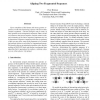Free Online Productivity Tools
i2Speak
i2Symbol
i2OCR
iTex2Img
iWeb2Print
iWeb2Shot
i2Type
iPdf2Split
iPdf2Merge
i2Bopomofo
i2Arabic
i2Style
i2Image
i2PDF
iLatex2Rtf
Sci2ools
83
Voted
IPPS
2002
IEEE
2002
IEEE
Aligning Two Fragmented Sequences
Upon completion of the human and mouse genome sequences, world-wide sequencing capacity will turn to other complex organisms. Current strategies call for many of these genomes to be incompletely sequenced. That is, holes will remain in the known sequence, and the relative order and orientation of the known sequence fragments may not be determined. Sequence comparison between two genomes of this sort may allow some of the fragments to be oriented and ordered relative to each other by computational means. We formalize this as an optimization problem, show that the problem is MAX-SNP hard, and develop a polynomial time algorithm that is guaranteed to produce a solution whose score is within a factor 3 of optimal.
Distributed And Parallel Computing | Genomes | IPPS 2002 | Mouse Genome Sequences | World-wide Sequencing Capacity |
Related Content
| Added | 15 Jul 2010 |
| Updated | 15 Jul 2010 |
| Type | Conference |
| Year | 2002 |
| Where | IPPS |
| Authors | Vamsi Veeramachaneni, Piotr Berman, Webb Miller |
Comments (0)

